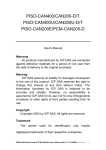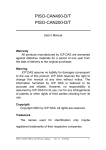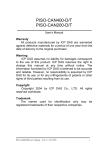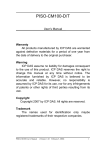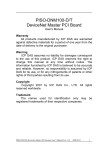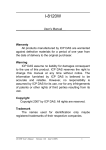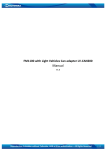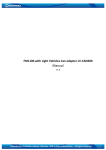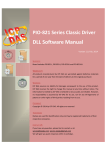Download Manual - ICP DAS USA`s I
Transcript
PISO-CAN400/CAN200-D/T
PISO-CAN400U/CAN200U-D/T
PEX-CAN200i-D/T
PCM-CAN100/PCM-CAN200-D
User’s Manual
Warranty
All products manufactured by ICP DAS are warranted
against defective materials for a period of one year from
the date of delivery to the original purchaser.
Warning
ICP DAS assume no liability for damages consequent
to the use of this product. ICP DAS reserves the right to
change this manual at any time without notice. The
information furnished by ICP DAS is believed to be
accurate and reliable. However, no responsibility is
assumed by ICP DAS for its use, nor for any infringements
of patents or other rights of third parties resulting from its
use.
Copyright
Copyright 2003 by ICP DAS. All rights are reserved.
Trademark
The names used for
identification only maybe
registered trademarks of their respective companies.
PISO-CAN/PEX-CAN/PCM-CAN Series User’s Manual (Ver :2.3 03/Aug/2010) ----------
1
Tables of Content
1
2
3
4
General Information................................................................................4
1.1 Introduction....................................................................................4
1.2 Features..........................................................................................5
1.3 Specifications ................................................................................6
1.4 Product Check List ........................................................................7
Hardware Configuration .........................................................................8
2.1 Board Layout..................................................................................8
2.2 Jumper Selection.........................................................................12
2.3 Connector Pin Assignment .........................................................15
2.3.1
5-pin screw terminal connector ....................................15
2.3.2
9-pin D-sub male connectors ........................................16
2.4 Installation....................................................................................17
Software Installation.............................................................................18
Installation DLL Driver..........................................................................22
4.1 DLL Function Definition and Description ..................................23
4.1.1
CAN_GetDllVersion ........................................................26
4.1.2
CAN_TotalBoard.............................................................26
4.1.3
CAN_GetBoardInf ...........................................................27
4.1.4
CAN_GetCardPortNum ..................................................28
4.1.5
CAN_ActiveBoard ..........................................................29
4.1.6
4.1.7
4.1.8
4.1.9
4.1.10
4.1.11
4.1.12
4.1.13
4.1.14
4.1.15
4.1.16
4.1.17
4.1.18
4.1.19
4.1.20
4.1.21
4.1.22
CAN_CloseBoard ...........................................................30
CAN_BoardIsActive........................................................31
CAN_Reset......................................................................32
CAN_Init ..........................................................................33
CAN_Config ....................................................................34
CAN_ConfigWithoutStructure .......................................36
CAN_EnableRxIrq...........................................................38
CAN_DisableRxIrq..........................................................39
CAN_RxIrqStatus............................................................40
CAN_InstallIrq.................................................................41
CAN_RemoveIrq .............................................................42
CAN_IrqStatus ................................................................43
CAN_Status.....................................................................44
CAN_SendMsg................................................................46
CAN_SendWithoutStruct ...............................................48
CAN_RxMsgCount .........................................................49
CAN_ReceiveMsg ...........................................................50
PISO-CAN/PEX-CAN/PCM-CAN Series User’s Manual (Ver :2.3 03/Aug/2010) ----------
2
5
6
7
4.1.23 CAN_ReceiveWithoutStruct...........................................52
4.1.24 CAN_ClearSoftBuffer .....................................................54
4.1.25 CAN_ClearDataOverrun .................................................55
4.1.26 CAN_OutputByte ............................................................56
4.1.27 CAN_InputByte ...............................................................57
4.1.28 CAN_GetSystemFreq .....................................................58
4.1.29 CAN_InstallUserIsr (only for Windows 2000/XP) .........59
4.1.30 CAN_RemoveUserIsr (only for Windows 2000/XP)......60
4.2 Flow Diagram for Application .....................................................61
Demo Programs for Windows..............................................................64
CANUtility Program for Windows........................................................67
Appendix ...............................................................................................73
7.1 Acceptance Filtering....................................................................73
PISO-CAN/PEX-CAN/PCM-CAN Series User’s Manual (Ver :2.3 03/Aug/2010) ----------
3
1
General Information
1.1 Introduction
The CAN (Controller Area Network) is a serial communication protocol,
which efficiently supports distributed real-time control with a very high level of
security. It is especially suited for networking "intelligent" devices as well as
sensors and actuators within a system or sub-system. In CAN networks, there
is no addressing of subscribers or stations in the conventional sense, but
instead prioritized messages are transmitted. As a stand-alone CAN controller,
PISO-CAN, PEX-CAN, and PCM-CAN represents an economic solution within
which an active CAN board can have two or four independent CAN bus
communication ports with either a 5-pin screw terminal connector or a 9-pin
D-sub connector. It can be a master/slave interface, and be applied in various
CAN applications. In addition, these CAN cards use the new NXP SJA1000T
and transceiver 82C250/251, which provide the bus arbitration and error
detection. The differences between these CAN cards are the interface of PC.
Some are for PCI interface, some are for PCI Express interface, and some are
for PCI-104 interface. To get the detail information for the features and the
specification of these CAN cards, please refer to the section 1.2 and 1.3.
PISO-CAN/PEX-CAN/PCM-CAN Series User’s Manual (Ver :2.3 03/Aug/2010) ----------
4
1.2 Features
z
PCI BUS interface
z
2500Vrms photo-isolation protection
z
Four or two independent CAN communication ports
z
Compatible with CAN specification 2.0 parts A and B
z
On-board optical isolation protection
z
Programmable transfer-rate up to 1 Mbps
z
Jumper select 120Ω terminator resistor for each port
z
Direct memory mapping to the CAN controllers
z
PISO-CAN200-D/T and PISO-CAN400-D/T
z
z
z
z
33MHz 32bit 5V PCI bus (V2.1) plug and play technology
PCI card, supports 5V PCI bus
3KV galvanic isolation
2/4 independent CAN channels for PISO-CAN 200/400
PISO-CAN200U-D/T and PISO-CAN400U-D/T
PCI v2.2 compliant 32-bit 33MHz
Universal PCI card, supports both 5V and 3.3V PCI bus
3KV galvanic isolation
2/4 independent CAN channels for PISO-CAN 200U/400U
PEX-CAN200i-D/T
32-bit, 33MHz, X1 PCI Express Bus
According to PCI Express specification R1.0
3KV galvanic isolation
2 independent CAN channels
PCM-CAN100-D and PCM-CAN200-D
PCI104 compliant
9-pin D-sub connector
1KV galvanic isolation
1/2 independent CAN channels
Driver supported for Windows 2000/XP
PISO-CAN/PEX-CAN/PCM-CAN Series User’s Manual (Ver :2.3 03/Aug/2010) ----------
5
1.3 Specifications
z
CAN controller: Phillips SJA1000T.
z
CAN transceiver: Phillips 82C250/251.
z
Signal support: CAN_H, CAN_L.
z
CAN controller frequency :16 MHz
z
Connector: 5-pin screw terminal connector or 9-pin D-sub male
connector.
z
Isolation voltage: 2500Vrms.
z
Power requirements:
PISO-CAN200: 5V@380mA
PISO-CAN400: 5V@640mA
PISO-CAN200U: 5V@165mA
PISO-CAN400U: 5V@300mA
PEX-CAN200i: 3.3V@100mA and 12V@200mA
PCM-CAN100: 5V@140mA
PCM-CAN200: 5V@165mA
z
Environmental:
Operating temp: 0~60℃
Storage temp: -20~80℃
Humidity: 0~90% non-condensing
Dimensions:
PISO-CAN200/400: 126mm X 85mm
PISO-CAN200U/400U: 126mm X 85mm
PEX-CAN200i: 120mm X 85mm
PCM-CAN100/200: 96mm X 90mm
PISO-CAN/PEX-CAN/PCM-CAN Series User’s Manual (Ver :2.3 03/Aug/2010) ----------
6
1.4 Product Check List
Besides this manual, the package includes the following items:
PISO-CAN200/PISO-CAN400/PISO-CAN200U/PISO-CAN
400U/PEX-CAN200i/PCM-CAN200/PCM-CAN100 card
ADP-9 Board (for PISO-CAN400/PISO-CAN400U only)
Software CD ROM
It is recommended that users read the release note first. All the
important information needed will be provided in the release note as
follows:
Where you can find the software driver, utility and demo programs.
How to install software & utility.
Where is the diagnostic program?
FAQ’s and answers.
Attention !
If any of these items are missing or damaged, please contact your local
field agent. Keep aside the shipping materials and carton in case you want to
ship or store the product in the future.
PISO-CAN/PEX-CAN/PCM-CAN Series User’s Manual (Ver :2.3 03/Aug/2010) ----------
7
2
Hardware Configuration
This section will describe the hardware settings of the PISO-CAN,
PEX-CAN, and PCM-CAN series CAN card. This information includes the wire
connection and terminal resistance configuration for the CAN network.
2.1 Board Layout
Figure2.1
PISO-CAN200 Board LAYOUT
PISO-CAN/PEX-CAN/PCM-CAN Series User’s Manual (Ver :2.3 03/Aug/2010) ----------
8
Figure2.2
Figure2.3
PISO-CAN400 Board LAYOUT
PISO-CAN200U Board LAYOUT
PISO-CAN/PEX-CAN/PCM-CAN Series User’s Manual (Ver :2.3 03/Aug/2010) ----------
9
Figure2.4
Figure2.5
PISO-CAN400U Board LAYOUT
ADP-9 Board LAYOUT (For PISO-CAN400/PISO-CAN400U Only)
PISO-CAN/PEX-CAN/PCM-CAN Series User’s Manual (Ver :2.3 03/Aug/2010) ----------
10
PEX-CAN200i
Figure2.6
PEX-CAN200i Board LAYOUT
Figure2.7. PCM-CAN200 Board LAYOUT
PISO-CAN/PEX-CAN/PCM-CAN Series User’s Manual (Ver :2.3 03/Aug/2010) ----------
11
2.2 Jumper Selection
PISO-CAN200-D/T and PISO-CAN400-D/T
Table 2.1 Jumper Selections
Jumper
Description
Status
JP1
JP1
JP1
CAN Port 3 Connector,
connecting PISO-CAN400
board and ADP-9 board.
1
2
3
1 2 3
Pin1: CAN_L
Pin2: CAN_H
Pin3: Shield
JP2
JP2
CAN Port 4 Connector,
connecting PISO-CAN400
board and ADP-9 board.
JP2
1
2
3
1 2 3
Pin1: CAN_L
Pin2: CAN_H
Pin3: Shield
JP6
Port 1 terminator
resister(120Ω) selection
Enable
Disable
1 2 3
1 2 3
JP7
Port 2 terminator
resister(120Ω) selection
1 2 3
1 2 3
JP8
Port 3 terminator
resister(120Ω) selection
1 2 3
1 2 3
JP9
Port 4 terminator
resister(120Ω) selection
1 2 3
1 2 3
PISO-CAN/PEX-CAN/PCM-CAN Series User’s Manual (Ver :2.3 03/Aug/2010) ----------
12
PISO-CAN200U-D/T and PISO-CAN400U-D/T
Table 2.2 Jumper Selections
Jumper
Description
Status
JP5
JP5
JP5
CAN Port 3 Connector,
connecting PISO-CAN400U
board and ADP-9 board.
1
2
3
1 2 3
Pin1: CAN_L
Pin2: CAN_H
Pin3: Shield
JP7
JP7
JP7
CAN Port 4 Connector,
connecting PISO-CAN400U
board and ADP-9 board.
1
2
3
1 2 3
Pin1: CAN_L
Pin2: CAN_H
Pin3: Shield
JP2
Port 1 terminator
resister(120Ω) selection
Enable
Disable
3 2 1
3 2 1
JP3
Port 2 terminator
resister(120Ω) selection
3 2 1
3 2 1
JP4
Port 3 terminator
resister(120Ω) selection
3 2 1
3 2 1
JP6
Port 4 terminator
resister(120Ω) selection
3 2 1
3 2 1
PISO-CAN/PEX-CAN/PCM-CAN Series User’s Manual (Ver :2.3 03/Aug/2010) ----------
13
PEX-CAN200i-D/T
Table 2.3 Jumper Selections
Jumper
Description
JP2
Port 1 terminator
resister(120Ω) selection
JP3
Port 2 terminator
resister(120Ω) selection
Status
Enable
Disable
3 2 1
3 2 1
3 2 1
3 2 1
PCM-CAN100 and PCM-CAN200
Table 2.3 shows the appropriate switch setting and signals used for each
module in the stack.
Table 2.4: Rotary Switch Settings
Switch Position
0 or 4 or 8
1 or 5 or 9
2 or 6
3 or 7
Module Slot
1
2
3
4
CLK
CLK0
CLK1
CLK2
CLK3
ID Select
IDSEL0
IDSEL1
IDSEL2
IDSEL3
INT
INTA
INTB
INTC
INTD
Table 2.5 Jumper Selections
Jumper
Description
JP3
Port 1 terminator
resister(120Ω) selection
JP4
(only for
PCM-CAN200)
Port 2 terminator
resister(120Ω) selection
Status
Enable
Disable
3 2 1
3 2 1
3 2 1
3 2 1
PISO-CAN/PEX-CAN/PCM-CAN Series User’s Manual (Ver :2.3 03/Aug/2010) ----------
14
2.3 Connector Pin Assignment
The PISO-CAN200-T/400-T/200U-T/400U-T, and PEX-CAN200i-T are
equipped with two/four sets of 5-pin screw terminal connectors, the
PISO-CAN200-D/400-D/200U-D/400U-D,
PEX-CAN200i-D
and
PCM-CAN100/200 are equipped with two/four sets of 9-pin D-sub male
connectors for wire connection of the CAN bus. The connector’s pin
assignment is specified as follows:
2.3.1 5-pin screw terminal connector
The 5-pin screw terminal connector of the CAN bus interface is shown in
Figure 2.8. The details for the pin assignment are presented in Table 2.6.
1
2
3
4
5
CAN-L Shield CAN-H
Figure2.8
5-pin screw terminal connector
Table 2.6: Pin assignment of 5-pin screw terminal connector
5-pin screw terminal connectors pin
assignment
1
Reserved
2
CAN_L
3
4
5
CAN_SHLD
CAN_H
Reserved
PISO-CAN/PEX-CAN/PCM-CAN Series User’s Manual (Ver :2.3 03/Aug/2010) ----------
15
2.3.2 9-pin D-sub male connectors
The 9-pin D-sub male connector of the CAN bus interface is shown in
Figure 2.9 and the corresponding pin assignments are given in Table 2.7.
Figure2.9
Table 2.7
9-pin D-sub male connector
Pin assignment of the 9-pin D-sub male connector
1
2
3
4
5
6
7
8
9
D-sub male connector pin
assignment
Reserved
CAN_L
Reserved
Reserved
CAN_SHLD
Reserved
CAN_H
Reserved
Reserved
PISO-CAN/PEX-CAN/PCM-CAN Series User’s Manual (Ver :2.3 03/Aug/2010) ----------
16
2.4 Installation
1. Configure the jumper settings on your PISO-CAN/PEX-CAN/PCM-CAN
in accordance with your particular requirements.
2. Shutdown your system and take off the chassis of your machine.
3. Plug in your PISO-CAN, PEX-CAN, or PCM-CAN series CAN card into
a suitable empty PCI slot.
4. Replace your chassis.
5. Plug your CAN bus cable(s) into the 5-pin screw terminal connector or
the 9-pin D-sub connector.
6. When the hardware installation is complete, please turn on the
computer again.
PISO-CAN/PEX-CAN/PCM-CAN Series User’s Manual (Ver :2.3 03/Aug/2010) ----------
17
3
Software Installation
The driver of PISO-CAN or PCM-CAN can be used in 2K/XP Windows
environments.
Users
can
find
the
driver
in
the
path
of
“\CAN\PCI\PISO-CAN200_400” in the Fieldbus_CD. Execute the
PISO-CAN.exe file to start install the driver.
Install the PISO-CAN or PCM-CAN card driver
Step 1: Insert the product CD into the CD-ROM and find the path \
CAN\PCI\PISO-CAN200_400\2K_XP (ex: the OS is Windows 2000 or XP).
Then execute the PISO-CAN.exe to install the PISO-CAN card driver.
PISO-CAN/PEX-CAN/PCM-CAN Series User’s Manual (Ver :2.3 03/Aug/2010) ----------
18
Step 2: Click “Next” to start the PISO-CAN installation.
Step 3: Select the folder where the PISO-CAN setup would be installed
and click “Next” button to continue.
PISO-CAN/PEX-CAN/PCM-CAN Series User’s Manual (Ver :2.3 03/Aug/2010) ----------
19
Step 4: Click the button “Install” to continue.
Step 5: Finally, restart the computer to complete the installation.
PISO-CAN/PEX-CAN/PCM-CAN Series User’s Manual (Ver :2.3 03/Aug/2010) ----------
20
When finishing the installation. The PISO-CAN folder would be found at
the Start menu shown as below.
Remove the PISO-CAN driver
If the PISO-CAN driver is not used any more, users can click the “Uninstall” to
remove the PISO-CAN driver below.
PISO-CAN/PEX-CAN/PCM-CAN Series User’s Manual (Ver :2.3 03/Aug/2010) ----------
21
4
Installation DLL Driver
The DLL driver is the collection of function calls on the PISO-CAN,
PEX-CAN and PCM-CAN series cards used for Windows 98/Me/NT4/2000/XP
systems. The application structure is presented in the following figure. The
user application programs which have been developed by the following
designated tools: VB, VC, Delphi and Borland C++ Builder…etc, can call the
PISOCAN.DLL driver in user mode.
And then the DLL driver will bypass the
function call into the KP_CAN.sys and windrvr6.sys (the windrvr6.sys is for
windows 98/Me/NT4) to access the hardware system, as shown in the
following Figure.
PISO-CAN/PEX-CAN/PCM-CAN Series User’s Manual (Ver :2.3 03/Aug/2010) ----------
22
4.1 DLL Function Definition and Description
All the functions provided in the PISO-CAN, PEX-CAN, or PCM-CAN
(hereinafter referred to as PISO-CAN) are listed in the following table and
detailed information for every function is presented in the following sub-section.
However, in order to make the descriptions more simplified and clear, the
attributes for the both the input and output parameter functions are given as
[input] and [output] respectively, as shown in following table.
Keyword
Set parameter by user before Get the data from this parameter
calling this function?
after calling this function?
[ input ]
Yes
No
[ output ]
No
Yes
Table 4.1 DLL function definition
PISO-CAN/PEX-CAN/PCM-CAN Series User’s Manual (Ver :2.3 03/Aug/2010) ----------
23
Function definition
Page
WORD CAN_GetDllVersion();
26
int CAN_TotalBoard();
int CAN_GetBoardInf(BYTE BoardNo, DWORD *dwVID, DWORD *dwDID,
DWORD *dwSVID, DWORD *dwSDID, DWORD
*dwIrqNo);
int CAN_GetCardPortNum(BYTE BoardNo, BYTE *bGetPortNum);
26
int CAN_ActiveBoard(BYTE wBoardNo)
int CAN_CloseBoard(BYTE wBoardNo);
int CAN_BoardIsActive(BYTE BoardNo);
int CAN_Reset(BYTE BoardNo, BYTE Port);
int CAN_Init(BYTE wBoardNo, BYTE Port);
27
28
29
30
31
32
33
34
int CAN_Config(BYTE BoardNo, BYTE Port, ConfigStruct *CanConfig);
int CAN_ConfigWithoutStructure(BYTE BoardNo, BYTE Port, DWORD
AccCode, DWORD AccMask, BYTE BaudRate, BYTE BT0, BYTE BT1);
int CAN_EnableRxIrq(BYTE BoardNo ,BYTE Port);
38
int CAN_DisableRxIrq(BYTE BoardNo, BYTE Port);
39
int CAN_RxIrqStatus(BYTE BoardNo, BYTE Port, BYTE *bStatus);
40
int CAN_InstallIrq(BYTE BoardNo);
41
int CAN_RemoveIrq(BYTE BoardNo);
42
int CAN_IrqStatus(BYTE BoardNo, BYTE *bStatus);
43
int CAN_Status(BYTE BoardNo, BYTE Port, BYTE *bStatus);
44
36
int CAN_SendMsg(BYTE BoardNo, BYTE Port, PacketStruct *CanPacket);
46
int CAN_SendWithoutStruct(BYTE BoardNo, BYTE Port, BYTE Mode,
DWORD Id, BYTE Rtr, BYTE Dlen, BYTE *Data) 48
int CAN_RxMsgCount(BYTE BoardNo, BYTE Port);
49
int CAN_ReceiveMsg(BYTE BoardNo, BYTE Port, PacketStruct *CanPacket); 50
int CAN_ReceiveWithoutStruct(BYTE BoardNo, BYTE Port, BYTE *Mode,
52
DWORD *Id, BYTE *Rtr, BYTE *Dlen, BYTE
*Data, LONGLONG *MsgTimeStamps);
int CAN_ClearSoftBuffer(BYTE BoardNo, BYTE Port);
54
int CAN_ClearDataOverrun(BYTE BoardNo, BYTE Port);
void CAN_OutputByte(BYTE BoardNo, BYTE Port, WORD wOffset, BYTE
bValue);
BYTE CAN_InputByte(BYTE BoardNo, BYTE Port, WORD wOffset);
55
56
LONGLONG CAN_GetSystemFreq(void);
58
Int CAN_InstallUserIsr(BYTE BoardNo, void(*UserISR)(BYTE BoardNo));
59
Int CAN_RemoveUserIsr(BYTE BoardNo);
60
57
PISO-CAN/PEX-CAN/PCM-CAN Series User’s Manual (Ver :2.3 03/Aug/2010) ----------
24
Table 4.2 Interpretation of the return code
Return Code
Error ID
Comment
0
CAN_NoError
OK
1
CAN_DriverError
Driver error
2
CAN_ActiveBoardError
This board can’t be activated.
3
CAN_BoardNumberError
4
CAN_PortNumberError
5
CAN_ResetError
The board number exceeds the
maximum board number (7).
The port number exceeds the
maximum port number.
CAN chip hardware reset error
6
CAN_SoftResetError
CAN chip software reset error
7
CAN_InitError
CAN chip initiation error
8
CAN_ConfigError
CAN chip configure error
9
CAN_SetACRError
10
CAN_SetAMRError
11
CAN_SetBaudRateError
Set to Acceptance Code Register
error
Set to Acceptance Mask Register
error
Set Baud Rate error
12
CAN_EnableRxIrqFailure
13
CAN_DisableRxIrqFailure
14
CAN_InstallIrqFailure
Enable CAN chip receive interrupt
failure
Disable CAN chip receive interrupt
failure
Installing PCI board IRQ failure
15
CAN_RemoveIrqFailure
Removing PCI board IRQ failure
16
CAN_TransmitBufferLocked
17
CAN_TransmitIncomplete
18
CAN_ReceiveBufferEmpty
Transmit buffer in CAN chip is
locked
Previously transmission is not yet
completed
CAN chip RXFIFO is empty
19
CAN_DataOverrun
20
CAN_ReceiveError
Data was lost because there was
not enough space in CAN chip
RXFIFO
Receive data is not completed
21
CAN_SoftBufferIsEmpty
Software buffer in driver is empty
22
CAN_SoftBufferIsFull
Software buffer in driver is full
23
CAN_TimeOut
Function no response and timeout
24
CAN_InstallIsrError
Installing user ISR failure
PISO-CAN/PEX-CAN/PCM-CAN Series User’s Manual (Ver :2.3 03/Aug/2010) ----------
25
4.1.1 CAN_GetDllVersion
z
Description:
Obtain the version information of PISOCAN.dll driver.
z
Syntax:
WORD
z
CAN_GetDllVersion(viod)
Parameter:
None
z
Return:
DLL version information. For example: If 101(hex) is return, it means
driver version is 1.01.
4.1.2 CAN_TotalBoard
z
Description:
Obtain the amount of all CAN boards installed in the PCI bus.
z
Syntax:
int
z
CAN_TotalBoard(void)
Parameter:
None
z
Return:
Return the amount of all board.
PISO-CAN/PEX-CAN/PCM-CAN Series User’s Manual (Ver :2.3 03/Aug/2010) ----------
26
4.1.3 CAN_GetBoardInf
z
Description:
Obtain the information of PISO-CAN boards, which include vender ID,
device ID and interrupt number.
z
Syntax:
int CAN_GetBoardInf(BYTE BoardNo, DWORD *dwVID, DWORD
*dwDID, DWORD *dwSVID,DWORD *dwSDID, DWORD *dwSAuxID,
DWORD *dwIrqNo)
z
z
Parameter:
BoardNo:
[input] PISO-CAN board number
*dwVID:
*dwDID:
*dwSVID:
*dwSDID:
*dwSAuxID:
*dwIrq:
[output] vendor ID of this board
[output] device ID of this board
[output] sub-vendor ID of this board
[output] sub-device ID of this board
[output] sub-auxiliary ID of this board
[output] logical interrupt number of this board
Return:
CAN_NoError: OK
CAN_DriverError:
Kernel driver can not be opened.
CAN_BoardNumberError: BoardNo exceeds the current total board
number.
PISO-CAN/PEX-CAN/PCM-CAN Series User’s Manual (Ver :2.3 03/Aug/2010) ----------
27
4.1.4 CAN_GetCardPortNum
z
Description:
Call this function to Get CAN port number of the PISO-CAN card.
z
Syntax:
int
z
CAN_GetCardPortNum(BYTE BoardNo, BYTE *bGetPortNum)
Parameter:
BoardNo:
[input] PISO-CAN board number (0~7).
* bGetPortNum: [output] Port number of the CAN card
z
Return:
CAN_NoError: OK
CAN_DriverError:
Kernel driver can not be opened.
CAN_BoardNumberError: BoardNo exceeds the current total board
number.
PISO-CAN/PEX-CAN/PCM-CAN Series User’s Manual (Ver :2.3 03/Aug/2010) ----------
28
4.1.5 CAN_ActiveBoard
z
Description:
Activate the device. It must be called once before using other
functions of PISO-CAN board.
z
Syntax:
int CAN_ActiveBoard(BYTE BoardNo)
z
Parameter:
BoardNo: [input] PISO-CAN board number (0~7).
z
Return:
CAN_NoError: OK
CAN_BoardNumberError: BoardNo exceeds the current total board
number.
CAN_ActiveBoardError: This board can not be activated or kernel driver
can not be found.
PISO-CAN/PEX-CAN/PCM-CAN Series User’s Manual (Ver :2.3 03/Aug/2010) ----------
29
4.1.6 CAN_CloseBoard
z
Description:
Stop and close the kernel driver and release the device resource from
computer device resource. This method must be called once before
exiting the user’s application program.
z
Syntax:
int CAN_CloseBoard(BYTE BoardNo)
z
Parameter:
BoardNo: [input] PISO-CAN board number (0~7).
z
Return:
CAN_NoError: OK
CAN_ActiveBoardError: The board is not activated
CAN_BoardNumberError: BoardNo exceeds the current total board
number.
PISO-CAN/PEX-CAN/PCM-CAN Series User’s Manual (Ver :2.3 03/Aug/2010) ----------
30
4.1.7 CAN_BoardIsActive
z
Description:
Obtain the information about the specific board is active or not.
z
Syntax:
int
z
CAN_BoardIsActive(BYTE BoardNo)
Parameter:
BoardNo: [input] PISO-CAN board number (0~7).
z
Return:
0: means the board is inactive.
1: means the board is active.
PISO-CAN/PEX-CAN/PCM-CAN Series User’s Manual (Ver :2.3 03/Aug/2010) ----------
31
4.1.8 CAN_Reset
z
Description:
Hardware reset CAN controller.
z
Syntax:
int CAN_Reset(BYTE BoardNo, BYTE Port)
z
Parameter:
BoardNo: [input] PISO-CAN board number (0~7).
Port: [input] CAN port number (1~4 or 1~2)
z
Return:
CAN_NoError: OK
CAN_DriverError: Kernel driver can’t be opened.
CAN_BoardNumberError: BoardNo is not correct or exceeds the current
total board number.
CAN_PortNumberError: Port number is not correct.
CAN_ActiveBoardError: This board is not activated.
PISO-CAN/PEX-CAN/PCM-CAN Series User’s Manual (Ver :2.3 03/Aug/2010) ----------
32
4.1.9 CAN_Init
z
Description:
Initiate CAN controller.
z
Syntax:
int
z
CAN_Init(BYTE BoardNo, BYTE Port)
Parameter:
BoardNo: [input] PISO-CAN board number (0~7).
Port: [input] CAN port number (1~4 or 1~2)
z
Return:
CAN_NoError: OK
CAN_DriverError: Kernel driver can’t be opened.
CAN_BoardNumberError: BoardNo is not correct or exceeds the current
total board number.
CAN_PortNumberError: Port number is not correct.
CAN_ActiveBoardError: This board is not activated.
CAN_InitError: Initiating CAN controller failure
PISO-CAN/PEX-CAN/PCM-CAN Series User’s Manual (Ver :2.3 03/Aug/2010) ----------
33
4.1.10 CAN_Config
z
Description:
Configure CAN controller. After calling this function, the CAN controller
will enter operating mode.
z
Syntax:
int
z
CAN_Config(BYTE BoardNo, BYTE Port,ConfigStruct
*CanConfig);
Parameter:
BoardNo: [input] PISO-CAN board number (0~7).
Port: [input] CAN port number (1~4 or 1~2)
*ConfigStruct: [input] The point of structure for ConfigStruct is defined as
following,
typedef struct config
{
BYTE AccCode[4];
BYTE AccMask[4];
BYTE BaudRate;
BYTE BT0, BT1;
} ConfigStruct;
AccCode[4]: Acceptance code for CAN controller.
AccMask[4]: Acceptance mask for CAN controller.
BaudRate: 0→user-defined(must to set BT0,BT1), 1→10Kbps,
2→20Kbps,
3→50Kbps, 4→125Kbps, 5→250Kbps,
6→500Kbps, 7→800Kbps, 8→1Mbps.
BT0, BT1: user-defined baud rate (used only if BaudRate=0)). For
PISO-CAN/PEX-CAN/PCM-CAN Series User’s Manual (Ver :2.3 03/Aug/2010) ----------
34
example, BT0=0x04, BT1=0x1C, then baud rate setting for
the CAN controller is 100Kbps. For more detail baud rate
setting, please refer to manual of SJA1000 CAN controller.
z
Return:
CAN_NoError: OK
CAN_DriverError: Kernel driver can’t be opened.
CAN_BoardNumberError: BoardNo is not correct or exceeds the current
total board number.
CAN_PortNumberError: Port number is not correct.
CAN_ActiveBoardError: This board is not activated.
CAN_SoftResetError: CAN controller software reset error.
CAN_SetACRError: Set Acceptance code to CAN controller error
CAN_SetAMRError: Set Acceptance mask to CAN controller error
CAN_SetBaudRateError: Set baud rate to CAN controller error
CAN_ConfigError: CAN controller enter operating mode failure.
PISO-CAN/PEX-CAN/PCM-CAN Series User’s Manual (Ver :2.3 03/Aug/2010) ----------
35
4.1.11 CAN_ConfigWithoutStructure
z
Description:
This function is the same as CAN_Config. But this function doesn’t use
ConfigStruct structure type. To provide this function is for that the
structure address of some application development is allocated different
from the PISOCAN.lib. So if users use CAN_Config and can’t configure
CAN card correctly, the CAN_ConfigWithoutStruct function can instead.
z
Syntax:
int
z
CAN_ConfigWithoutStructure(BYTE BoardNo, BYTE Port,
DWORD AccCode, DWORD AccMask, BYTE BaudRate,
BYTE BT0, BYTE BT1);
Parameter:
BoardNo: [input] PISO-CAN board number (0~7).
Port: [input] CAN port number (1~4 or 1~2)
AccCode: Acceptance code for CAN controller.
AccMask: Acceptance mask for CAN controller.
BaudRate: 0→user-defined(must to set BT0,BT1), 1→10Kbps,
2→20Kbps,
3→50Kbps, 4→125Kbps, 5→250Kbps,
6→500Kbps, 7→800Kbps, 8→1Mbps.
BT0, BT1: user-defined baud rate (used only if BaudRate=0)). For
example, BT0=0x04, BT1=0x1C, then baud rate setting for
the CAN controller is 100Kbps. For more detail baud rate
setting, please refer to manual of SJA1000 CAN controller.
z
Return:
CAN_NoError: OK
PISO-CAN/PEX-CAN/PCM-CAN Series User’s Manual (Ver :2.3 03/Aug/2010) ----------
36
CAN_DriverError: Kernel driver can’t be opened.
CAN_BoardNumberError: BoardNo is not correct or exceeds the current
total board number.
CAN_PortNumberError: Port number is not correct.
CAN_ActiveBoardError: This board is not activated.
CAN_SoftResetError: CAN controller software reset error.
CAN_SetACRError: Set Acceptance code to CAN controller error
CAN_SetAMRError: Set Acceptance mask to CAN controller error
CAN_SetBaudRateError: Set baud rate to CAN controller error
CAN_ConfigError: CAN controller enter operating mode failure.
PISO-CAN/PEX-CAN/PCM-CAN Series User’s Manual (Ver :2.3 03/Aug/2010) ----------
37
4.1.12 CAN_EnableRxIrq
z
Description:
Enable receive interrupt for CAN controller.
z
Syntax:
int
z
CAN_EnableRxIrq(BYTE BoardNo, BYTE Port)
Parameter:
BoardNo: [input] PISO-CAN board number (0~7).
Port: [input] CAN port number (1~4 or 1~2)
z
Return:
CAN_NoError: OK
CAN_DriverError: Kernel driver can’t be opened.
CAN_BoardNumberError: BoardNo is not correct or exceeds the current
total board number.
CAN_PortNumberError: Port number is not correct.
CAN_ActiveBoardError: This board is not activated.
CAN_EnableRxIrqFailure: Enable receives interrupt failure.
PISO-CAN/PEX-CAN/PCM-CAN Series User’s Manual (Ver :2.3 03/Aug/2010) ----------
38
4.1.13 CAN_DisableRxIrq
z
Description:
Disable receive interrupt of the CAN controller.
z
Syntax:
Int CAN_DisableRxIrq(BYTE BoardNo, BYTE Port)
z
Parameter:
BoardNo: [input] PISO-CAN board number (0~7)
Port: [input] CAN port number (1~4 or 1~2)
z
Return:
CAN_NoError: OK
CAN_DriverError: Kernel driver can’t be opened.
CAN_BoardNumberError: BoardNo is not correct or exceeds the current
total board number.
CAN_PortNumberError: Port number is not correct.
CAN_ActiveBoardError: This board is not activated.
CAN_DisableRxIrqFailure: Disable receives interrupt failure.
PISO-CAN/PEX-CAN/PCM-CAN Series User’s Manual (Ver :2.3 03/Aug/2010) ----------
39
4.1.14 CAN_RxIrqStatus
z
Description:
Obtain receive interrupt status of the CAN controller.
z
Syntax:
int CAN_RxIrqStatus(BYTE BoardNo, BYTE Port, BYTE *bStatus)
z
Parameter:
BoardNo: [input] PISO-CAN board number (0~7)
Port: [input] CAN port number (1~4 or 1~2)
*bStatus:[output] 0→receive interrupt disable;
1→ receive interrupt enable.
z
Return:
CAN_NoError: OK
CAN_DriverError: Kernel driver can’t be opened.
CAN_BoardNumberError: BoardNo is not correct or exceeds the current
total board number.
CAN_PortNumberError: Port number is not correct.
CAN_ActiveBoardError: This board is not activated.
PISO-CAN/PEX-CAN/PCM-CAN Series User’s Manual (Ver :2.3 03/Aug/2010) ----------
40
4.1.15 CAN_InstallIrq
z
Description:
Enable or start IRQ for PISO-CAN board. Before calling this function,
CAN_EnableRxIrq must to be called first.
z
Syntax:
int CAN_InstallIrq(BYTE BoardNo)
z
Parameter:
BoardNo: [input] PISO-CAN board number (0~7).
z
Return:
CAN_NoError: OK
CAN_DriverError: Kernel driver can’t be opened.
CAN_BoardNumberError: BoardNo is not correct or exceeds the current
total board number.
CAN_ActiveBoardError: This board is not activated.
CAN_InstallIrqFailure: Enable or start IRQ failure.
PISO-CAN/PEX-CAN/PCM-CAN Series User’s Manual (Ver :2.3 03/Aug/2010) ----------
41
4.1.16 CAN_RemoveIrq
z
Description:
Disable or stop IRQ for PISO-CAN board. After calling this function, the
interrupts for all CAN controllers on board will be disabled.
z
Syntax:
int CAN_RemoveIrq(BYTE BoardNo)
z
Parameter:
BoardNo: [input] PISO-CAN board number (0~7).
z
Return:
CAN_NoError: OK
CAN_DriverError: Kernel driver can’t be opened.
CAN_BoardNumberError: BoardNo is not correct or exceeds the current
total board number.
CAN_ActiveBoardError: This board is not activated.
CAN_RemoveIrqFailure: Disable or stop IRQ failure.
PISO-CAN/PEX-CAN/PCM-CAN Series User’s Manual (Ver :2.3 03/Aug/2010) ----------
42
4.1.17 CAN_IrqStatus
z
Description:
Obtain IRQ status of the PISO-CAN board.
z
Syntax:
int CAN_IrqStatus(BYTE BoardNo, BYTE *bStatus)
z
Parameter:
BoardNo: [input] PISO-CAN board number (0~7).
*bStatus:[output] 0→IRQ disable;
1→ IRQ enable.
z
Return:
CAN_NoError: OK
CAN_DriverError: Kernel driver can’t be opened.
CAN_BoardNumberError: BoardNo is not correct or exceeds the current
total board number.
CAN_ActiveBoardError: This board is not activated.
PISO-CAN/PEX-CAN/PCM-CAN Series User’s Manual (Ver :2.3 03/Aug/2010) ----------
43
4.1.18 CAN_Status
z
Description:
Obtain the status of CAN controller for PISO-CAN board.
z
Syntax:
int CAN_Status(BYTE BoardNo, BYTE Port,BYTE *bStatus)
z
Parameter:
BoardNo: [input] PISO-CAN board number (0~7).
*bStatus:[output] Status value of CAN controller.
Table 4.3
Bit
z
Bit interpretation of the bStatus.
NAME
VALUE
STATUS
bit 7 Bus Status
1
0
bus-off
bus-on
bit 6 Error Status
1
0
error
ok
bit 5 Transmit Status
1
0
transmit
idle
bit 4 Receive Status
1
0
receive
idle
bit 3 Transmission Complete Status
1
complete
0
incomplete
bit 2 Transmit Buffer Status
1
0
release
locked
bit 1 Data Overrun Status
1
0
overrun
absent
bit 0 Receive Buffer Status
1
0
full/not empty
empty
Return:
CAN_NoError: OK
PISO-CAN/PEX-CAN/PCM-CAN Series User’s Manual (Ver :2.3 03/Aug/2010) ----------
44
CAN_BoardNumberError: BoardNo is not correct or exceeds the current
total board number.
CAN_PortNumberError: Port number is not correct.
CAN_ActiveBoardError: This board is not activated.
PISO-CAN/PEX-CAN/PCM-CAN Series User’s Manual (Ver :2.3 03/Aug/2010) ----------
45
4.1.19 CAN_SendMsg
z
Description:
Send a CAN message immediately.
z
Syntax:
int
z
CAN_SendMsg(BYTE BoardNo, BYTE Port, PacketStruct
*CanPacket)
Parameter:
BoardNo: [input] PISO-CAN board number (0~7)
Port: [input] CAN port number (1~4 or 1~2)
*CanPacket: [input] The point of structure for CanPacket is defined as
following,
typedef struct packet
{
LONGLONG MsgTimeStamps;
BYTE mode;
DWORD id;
BYTE
rtr;
BYTE
len;
BYTE
data[8];
} PacketStruct;
MsgTimeStamps: Not use in this function.
mode: 0→ 11-bit identifier, 1 → 29-bit identifier.
id: Identifier
rtr: Remote transmission request
len: Data length
PISO-CAN/PEX-CAN/PCM-CAN Series User’s Manual (Ver :2.3 03/Aug/2010) ----------
46
data[8]: data byte
z
Return:
CAN_NoError: OK
CAN_BoardNumberError: BoardNo is not correct or exceeds the current
total board number.
CAN_PortNumberError: Port number is not correct.
CAN_ActiveBoardError: This board is not activated.
CAN_TransmitBufferLocked: Transmit buffer in CAN chip is locked.
CAN_TransmitIncomplete: Transmission is not yet completed.
CAN_ConfigError: Port has not been configured successfully.
PISO-CAN/PEX-CAN/PCM-CAN Series User’s Manual (Ver :2.3 03/Aug/2010) ----------
47
4.1.20 CAN_SendWithoutStruct
z
Description:
This function is the same as CAN_SendMsg. But this function doesn’t
use PacketStruct structure type. If users use CAN_SendMsg and can’t
send CAN message correctly with some application development like
dot Net 2003, the CAN_SendWithoutStruct function can instead.
z
Syntax:
int
z
CAN_SendWithoutStruct(BYTE BoardNo, BYTE Port, BYTE Mode,
DWORD Id, BYTE Rtr, BYTE Dlen, BYTE *Data)
Parameter:
BoardNo: [input] PISO-CAN board number (0~7)
Port: [input] CAN port number (1~4 or 1~2)
Mode: 0→ 11-bit identifier, 1 → 29-bit identifier.
Id: Identifier
Rtr: Remote transmission request
Dlen: Data length
*Data: data byte
z
Return:
CAN_NoError: OK
CAN_BoardNumberError: BoardNo is not correct.
CAN_PortNumberError: Port number is not correct.
CAN_ActiveBoardError: This board is not activated.
CAN_TransmitBufferLocked: Transmit buffer in CAN chip is locked.
CAN_TransmitIncomplete: Transmission is not yet completed.
CAN_ConfigError: Port has not been configured successfully.
PISO-CAN/PEX-CAN/PCM-CAN Series User’s Manual (Ver :2.3 03/Aug/2010) ----------
48
4.1.21 CAN_RxMsgCount
z
Description:
Obtain the amount of CAN messages available within the CAN
controller’s RXFIFO or the software buffer (4KBytes). After calling the
functions CAN_EnableRxIrq and CAN_InstallIrq, the amount of CAN
messages is within the software buffer; otherwise it is within the CAN
controller’s RXFIFO.
z
Syntax:
int CAN_RxMsgCount(BYTE BoardNo, BYTE Port);
z
Parameter:
BoardNo: [input] PISO-CAN board number (0~7)
Port: [input] CAN port number (1~4 or 1~2)
z
Return:
The amount of CAN messages.
Note. If the parameter for BoardNo or Port isn’t correct, the return value
will always be 0.
PISO-CAN/PEX-CAN/PCM-CAN Series User’s Manual (Ver :2.3 03/Aug/2010) ----------
49
4.1.22 CAN_ReceiveMsg
z
Description:
Obtain receive message from CAN controller’s RXFIFO or software
buffer.
After
calling
the
functions
CAN_EnableRxIrq
and
CAN_InstallIrq, the messages is within the software buffer, otherwise it
is within the CAN controller’s RXFIFO.
Note! If users’ PC go into “Standby mode” or “Sleep mode”, this
function will can’t receive any message.
z
Syntax:
int CAN_ReceiveMsg(BYTE BoardNo, BYTE Port, PacketStruct
*CanPacket)
z
Parameter:
BoardNo: [input] PISO-CAN board number (0~7)
Port: [input] CAN port number (1~4 or 1~2)
*CanPacket: [output] The structure for CanPacket is defined below,
typedef struct packet
{
LONGLONG MsgTimeStamps;
BYTE mode;
DWORD id;
BYTE
rtr;
BYTE
len;
BYTE
data[8];
} PacketStruct;
MsgTimeStamps: This parameter in Windows 98/Me/NT4 will record the
PISO-CAN/PEX-CAN/PCM-CAN Series User’s Manual (Ver :2.3 03/Aug/2010) ----------
50
time with system clock counter and in Windows 2000
/XP will record the system interrupt-time count of
100-ns unit when the CAN message is received from
SJA1000. The system clock counter starts to count
after the PC boots up. If more than one CAN
messages are received and stored in the 64-byte
SJA1000 FIFO, the time stamps of these CAN
messages may be closed.
mode: 0→ 11-bit identifier, 1 → 29-bit identifier.
id: Identifier
rtr: Remote transmission request
len: Data length
data[8]: data byte
z
Return:
CAN_NoError: OK
CAN_BoardNumberError: BoardNo is not correct or exceeds the current
total board number.
CAN_PortNumberError: Port number is not correct.
CAN_ActiveBoardError: This board is not activated.
CAN_ConfigError: Port has not been configured successfully.
CAN_ReceiveBufferEmpty: CAN controller’s RXFIFO is empty.
CAN_SoftBufferIsEmpty: Software RX Buffer is empty.
CAN_SoftBufferIsFull: Software RX Buffer Is full.
PISO-CAN/PEX-CAN/PCM-CAN Series User’s Manual (Ver :2.3 03/Aug/2010) ----------
51
4.1.23 CAN_ReceiveWithoutStruct
z
Description:
This function is the same as CAN_ReceiveMsg. But this function
doesn’t use PacketStruct structure type. To provide this function is for
that the structure address of some application development is allocated
different from the PISOCAN.lib like dot Net 2003. So if users use
CAN_ReceiveMsg and can’t receive CAN message correctly, the
CAN_ReceiveWithoutStruct function can instead.
z
Syntax:
int
z
CAN_ReceiveWithoutStruct(BYTE BoardNo, BYTE Port, BYTE
*Mode, DWORD *Id, BYTE *Rtr, BYTE *Dlen,
BYTE *Data, DWORD *H_MsgTimeStamps,
DWORD *L_MsgTimeStamps)
Parameter:
BoardNo: [input] PISO-CAN board number (0~7)
Port: [input] CAN port number (1~4 or 1~2)
*Mode: 0→ 11-bit identifier, 1 → 29-bit identifier.
*Id: Identifier
*Rtr: Remote transmission request
*Dlen: Data length
*Data: data byte
*H_MsgTimeStamps,
*L_MsgTimeStamps:
These
parameters
in
Windows 98/Me/NT4 will record the time with system clock
counter and in Windows 2000/XP will record the system
interrupt-time count of 100-ns unit when the CAN message is
received from SJA1000. The *H_MsgTimeStamps is the high
PISO-CAN/PEX-CAN/PCM-CAN Series User’s Manual (Ver :2.3 03/Aug/2010) ----------
52
DWORD and the *L_MsgTimeStamps is the low DWORD The
system clock counter starts to count after the PC boots up. If
more than one CAN messages are received and stored in the
64-byte SJA1000 FIFO, the time stamps of these CAN
messages may be closed.
z
Return:
CAN_NoError: OK
CAN_BoardNumberError: BoardNo is not correct or exceeds the current
total board number.
CAN_PortNumberError: Port number is not correct.
CAN_ActiveBoardError: This board is not activated.
CAN_ConfigError: Port has not been configured successfully.
CAN_ReceiveBufferEmpty: CAN controller’s RXFIFO is empty.
CAN_SoftBufferIsEmpty: Software RX Buffer is empty.
CAN_SoftBufferIsFull: Software RX Buffer is full.
PISO-CAN/PEX-CAN/PCM-CAN Series User’s Manual (Ver :2.3 03/Aug/2010) ----------
53
4.1.24 CAN_ClearSoftBuffer
z
Description:
Clear the software buffer of the PISOCAN.DLL driver.
z
Syntax:
int
z
CAN_ClearSoftBuffer(BYTE BoardNo, BYTE Port)
Parameter:
BoardNo: [input] PISO-CAN board number (0~7)
Port: [input] CAN port number (1~4 or 1~2)
z
Return:
CAN_NoError: OK
CAN_BoardNumberError: BoardNo is not correct or exceeds the current
total board number.
CAN_PortNumberError: Port number is not correct.
PISO-CAN/PEX-CAN/PCM-CAN Series User’s Manual (Ver :2.3 03/Aug/2010) ----------
54
4.1.25 CAN_ClearDataOverrun
z
Description:
Clear the data overrun status bit for the CAN controller.
z
Syntax:
int
z
CAN_ClearDataOverrun(BYTE BoardNo, BYTE Port)
Parameter:
BoardNo: [input] PISO-CAN board number (0~7)
Port: [input] CAN port number (1~4 or 1~2)
z
Return:
CAN_NoError: OK
CAN_BoardNumberError: BoardNo is not correct or exceeds the current
total board number.
CAN_PortNumberError: Port number is not correct.
CAN_ActiveBoardError: This board is not activated.
CAN_ConfigError: CAN controller enter operating mode failure.
PISO-CAN/PEX-CAN/PCM-CAN Series User’s Manual (Ver :2.3 03/Aug/2010) ----------
55
4.1.26 CAN_OutputByte
z
Description:
Write data to CAN chip (SJA1000).
z
Syntax:
void CAN_OutputByte(BYTE BoardNo, BYTE Port, WORD wOffset,
BYTE bValue)
z
Parameter:
BoardNo: [input] PISO-CAN board number (0~7)
Port: [input] CAN port number (1~4 or 1~2)
wOffset: [input] Address offset from base address
bValue: [input] Data byte
z
Return:
None.
PISO-CAN/PEX-CAN/PCM-CAN Series User’s Manual (Ver :2.3 03/Aug/2010) ----------
56
4.1.27 CAN_InputByte
z
Description:
Read data from CAN chip (SJA1000).
z
Syntax:
BYTE
z
CAN_InputByte(BYTE BoardNo, BYTE Port, WORD wOffset)
Parameter:
BoardNo: [input] PISO-CAN board number (0~7)
Port: [input] CAN port number (1~4 or 1~2)
wOffset: [input] Address offset from base address
z
Return:
Data Byte of CAN chip.
PISO-CAN/PEX-CAN/PCM-CAN Series User’s Manual (Ver :2.3 03/Aug/2010) ----------
57
4.1.28 CAN_GetSystemFreq
z
Description:
Get the clock frequency. It is useful for calculate the time of the time
stamp for reception message.
z
Syntax:
LONGLONG
z
CAN_GetSystemFreq(void)
Parameter:
None
z
Return:
In Windows 98/Me/NT4 is clock frequency, in Windows 2000/XP is
always 10000000.
PISO-CAN/PEX-CAN/PCM-CAN Series User’s Manual (Ver :2.3 03/Aug/2010) ----------
58
4.1.29 CAN_InstallUserIsr (only for Windows 2000/XP)
z
Description:
Using this function can allow users to apply ISR (interrupt service
routine). When users put their ISR into this function, the interrupt of
receiving CAN message will trigger the users’ ISR.
z
Syntax:
int CAN_InstallUserIsr(BYTE BoardNo,
void(*UserISR)(BYTE BoardNo))
z
Parameter:
BoardNo: [input] PISO-CAN board number (0~7)
(*UserISR)(BYTE BoardNo): [input] The pointer which points a function
with format “void XXX(BYTE BoardNo)”.
The XXX is the function name of users’
ISR. The parameter, BoardNo, indicates
the number of the board which produces
an interrupt signal.
z
Return:
CAN_NoError: OK
CAN_DriverError: Kernel driver can’t be opened.
CAN_BoardNumberError: BoardNo is not correct or exceeds the current
total board number.
CAN_ActiveBoardError: This board is not activated.
CAN_InstallIrqFailure: Enable or start IRQ failure.
CAN_InstallIsrError: Enable or start ISR failure.
PISO-CAN/PEX-CAN/PCM-CAN Series User’s Manual (Ver :2.3 03/Aug/2010) ----------
59
4.1.30 CAN_RemoveUserIsr (only for Windows 2000/XP)
z
Description:
When users don’t need the ISR function, call this function to remove
users ISR.
z
Syntax:
Int CAN_RemoveUserIsr(BYTE BoadNo)
z
Parameter:
BoardNo: [input] PISO-CAN board number (0~7)
z
Return:
CAN_NoError: OK
CAN_DriverError: Kernel driver can’t be opened.
CAN_BoardNumberError: BoardNo is not correct or exceeds the current
total board number.
CAN_ActiveBoardError: This board is not activated.
CAN_RemoveIrqFailure: Disable or stop IRQ failure.
PISO-CAN/PEX-CAN/PCM-CAN Series User’s Manual (Ver :2.3 03/Aug/2010) ----------
60
4.2 Flow Diagram for Application
In this section, we will show the operation procedure of PISO-CAN/PEX-CAN
/PCM-CAN board for sending and receiving CAN message. Figure 4.1 presents
the “Send CAN Message” procedure. Figure 4.2 and 4.3 stand for the “receiving
CAN Message” in polling and in interrupt mode, respectively.
Users need to
follow the operation principle of PISO-CAN/PEX-CAN/PCM-CAN board for
correctly and easily send and receive the CAN message through CAN network.
For more detail information, please refer to the demo programs in section 5.
Figure 4.1 Flow Chart “Send CAN Massage”
PISO-CAN/PEX-CAN/PCM-CAN Series User’s Manual (Ver :2.3 03/Aug/2010) ----------
61
Start of Application
CAN_ActiveBoard
CAN_Reset
CAN_Init
CAN_Config
CAN_RxMsgCount>0?
NO
YES
CAN_ReceiveMsg
CAN_CloseBoard
End of Application
Figure 4.2 Flow Chart “Receive CAN Massage”
PISO-CAN/PEX-CAN/PCM-CAN Series User’s Manual (Ver :2.3 03/Aug/2010) ----------
62
Start of Application
CAN_ActiveBoard
CAN_Reset
CAN_Init
CAN_Config
CAN_EnableRxIrq
CAN_InstallIrq
CAN_RxMsgCount>0?
NO
YES
CAN_ReceiveMsg
CAN_DisableRxIrq
CAN_RemoveIrq
CAN_CloseBoard
End of Application
Figure 4.3 Flow Chart “Receive CAN Massage with IRQ”
PISO-CAN/PEX-CAN/PCM-CAN Series User’s Manual (Ver :2.3 03/Aug/2010) ----------
63
5
Demo Programs for Windows
All of demo programs will not work normally if DLL driver would not be
installed correctly. During the installation process of DLL driver, the install-shields
will register the correct kernel driver to the operation system and copy the DLL
driver and demo programs to the correct position based on the driver software
package you have selected (Win98,Me,NT,win2000,XP). After driver installation,
the related demo programs and development library and declaration header files
for different development environments are presented as follows.
|--\Demo
|--\BCB3
|
|--\CAN.H
|
|--\PISOCAN.LIB
|
|
|--\Delphi4
|
|--\CAN.PAS
|
|--\VC6
|
|--\CAN.H
|
|--\PISOCAN.LIB
|
|--\VB6
|--\CAN.BAS
Æ Demo program
Æ for Borland C++ Builder 3
Æ Header file
Æ Linkage library for BCB
Æ for Delphi 4
Æ Declaration file
Æ for Visual C++ 6
Æ Header file
Æ Linkage library for VC6
Æ for Visual Basic 6
Æ Declaration file
The list of demo programs:
DEMO1:
DEMO2:
Transmit and receive CAN messages.
Transmit and receive CAN messages with IRQ
PISO-CAN/PEX-CAN/PCM-CAN Series User’s Manual (Ver :2.3 03/Aug/2010) ----------
64
A brief introduction of the demo programs
DEMO1:
Demo1 is the example used for starting the PISO-CAN/PEX-CAN
/PCM-CAN board. This demo program is designed to send out the CAN
message through Port 1 and receive the CAN message immediately at port 2
in the same PISO-CAN/PEX-CAN/PCM-CAN board. Before exercising this
demo, the user needs to finish the CAN median wiring connection between
port 1 and port 2.
Based on this demo, the user can key in the CAN message
into the port 1 frame area and then click the “Send” button in order to send out
the CAN message to port 2. If you click the “Receive” button in the CAN port
2 frame area, the CAN message received by CAN port 2 will be presented in
“TEXT” box. This is shown in the below screenshot. Note that if port 2 displays
a warning message like CAN Data Overrun, then it is an indication that the
un-read messages within the 64 bytes RXFIFO CAN buffer have been covered
by another message. This means that the messages that are being received
from the CAN bus may be in error and/or they may be missing part of the
message. Then the user can click on the “Clear Overrun” button to clear the
RXFIFO buffer overrun status within the CAN controller.
Figure 5.1: The form of demo1 program
DEMO2:
PISO-CAN/PEX-CAN/PCM-CAN Series User’s Manual (Ver :2.3 03/Aug/2010) ----------
65
In demo 2, we provide a demonstration on how to send out a CAN
message through port 1 and receive the CAN message in port 2 by means of
the interrupt mode. Contained within this operation, the user can key in the
CAN message into the port 1 frame area and click on the “Send” button to
send out the CAN message. At the same time, the CAN message will be
received at port 2 by means of the interrupt mode. As shown in the following
figure, port 2 can automatically receive the CAN message and store it within
the 4K bytes of buffer software. When the user clicks the “Receive” button, all
the messages stored in the 4K bytes buffer will all be presented in the TEXT
edit area, as shown in the following figure.
Figure 5.2: The form of demo2 program
PISO-CAN/PEX-CAN/PCM-CAN Series User’s Manual (Ver :2.3 03/Aug/2010) ----------
66
6
CANUtility Program for Windows
For PISO-CAN, PEX-CAN, or PCM-CAN, we provide a friendly CAN bus
utility tool to allow users to send/receive the CAN messages to/from CAN
network easily. This utility tool can be thought as a useful tool for monitoring
CAN messages or testing CAN devices on the CAN network. It supplies
several functions, such as sending CAN messages, receiving CAN messages,
storing CAN messages, cyclic transmission, and so forth. The operation
principle will be addressed in the following sub-section.
(1) CAN Configure Dialog
Please click the Board No combo box to select which CAN board plugged
on the pc will be used.
Check the Port Enable check boxes to enable CAN ports. Then select
CAN port tag. According to CAN communication requirement, users need to
set the proper baud rate, acceptance code and acceptance mask. The Baud
Rate combo box has eight kinds of baud, 10K, 20K, 50K, 125K, 250K, 500K,
800K, and 1M. Users can also define the special baud by using BT0 and BT1
field. If users select the user defined baud rate, users must have the
background of the CAN chip, SJA1000. Afterwards, click OK to save the
configuration.
PISO-CAN/PEX-CAN/PCM-CAN Series User’s Manual (Ver :2.3 03/Aug/2010) ----------
67
(2) Main Dialog
The CAN Utility main dialog is as following figure. There are 1 tag, 2 tags
and 4 tags for one-port card (PCM-CAN100), two-port card
(PISO-CAN200/200U, PEX-CAN200i, and PCM-CAN200) and four-port card
(PISO-CAN400/400U) respectively. In the bottom of the main dialog, the status
bar shows five parameters, board number, port status, baud rate, acceptance
code, and acceptance mask for the selected port.
(3) CAN Transmission Function
In the CAN port transmits part page as follow figure, there are four function
buttons for transmission list to use.
Add Button: User can key in the CAN message into the text boxes above
the transmission list. Then click add button to insert this CAN message into
PISO-CAN/PEX-CAN/PCM-CAN Series User’s Manual (Ver :2.3 03/Aug/2010) ----------
68
transmission list. The transmission list can include maximum 20 CAN
messages. After adding the message into transmission list, users can send
this message to CAN network by using Send button.
Modify Button: If users want to modify the content of some CAN message
in the transmission list, select this CAN messages in the transmission list firstly.
Then, this CAN message information will be shown in the text boxes above the
transmission list. Users can modify the CAN message in these text boxes
directly. Finally, click Modify button to save the modification in the transmission
list.
Delete Button: If some CAN message in the transmission list is useless,
users can select it and click delete button to delete this CAN message from
transmission list.
Send Button: After users select one CAN message from transmission list,
click Send button to send this CAN message once from the selected CAN port.
If the timer parameter of this CAN message is not 0, the CAN message will be
send depending on this timer parameter periodically. In this case, the status
filed of this CAN message in transmission list will display “Running”, and the
text shown on the Send button will be changed to “Pause”. If uses want to stop
the message transmission, click this button again. There are only 5 CAN
message can be sending cyclically from one CAN port at the same time.
(4) CAN Reception Function
The following figure shows the receive part of a selected CAN port. There
are four functions for reception list.
PISO-CAN/PEX-CAN/PCM-CAN Series User’s Manual (Ver :2.3 03/Aug/2010) ----------
69
Rx Pause: Click this button to stop the CAN message reception from
specific CAN port. Click it again to continue the message reception.
Clear Button: Click this button to delete all CAN messages shown in the
reception list.
Goto Last: Click this button to show the last received CAN message.
Scrolling Button: When the button is pushed down, the reception list is
always scrolled automatically to the last received CAN message. If this button
is pushed up, the reception list will stop to scroll automatically, but reception list
still get the CAN messages from CAN port. The default status of this button is
pushed down.
(5) Menu Function
There are three functions on the CAN Utility menu.
File Menu:
Load Configuration: If users had have saved the configuration
by using CANUtility before, users can click Load Configuration
function to load the older records into these lists of CAN Utility.
Save Configuration: The function is used for saving the
transmission list, data format list, and ID mask list of each CAN
port to a .txt file.
Save Reception List: Save Receive List, is used for saving the
CAN messages that is received on the reception list. The data in
PISO-CAN/PEX-CAN/PCM-CAN Series User’s Manual (Ver :2.3 03/Aug/2010) ----------
70
the reception list of each different CAN port will be saved into
different .txt file except that the reception list has no message.
For example, if users want to save the data in the reception list to
“test.txt“ file, generally, these data will be saved to four .txt files,
text_port01.txt,
text_port02.txt,
text_port03.txt,
and
text_port04.txt when users using PISO-CAN400. If the reception
list of the port 2 has no data, the text_port02.txt file will not be
produced.
Update Firmare: Update firmware of the CAN board. This
function can not be used to the PISO-CAN, PEX-CAN, and
PCM-CAN, it only for PISO-CM100/U, PISO-CPM100/U, and
PISO-DNM100/U.
Configuration Menu:
Board Configuration: Users can click “Board Configuration” to
re-configure the CAN board. Please refer to “(1) CAN Configure
Dialog” of this section for more detail information.
Data Format: In this function, user can set what kind of format
(such as hexadecimal, decimal, or ASCII) the CAN message with
specific ID will be displayed on the reception list. The setting
dialog is as follows. For example, set the data format of the byte2
~ byte6 of the CAN message with ID 0x1AA to the decimal format.
Then, the reception list will display the byte2 ~ byte 6 data of the
message with ID 0x1AA by using decimal format, and display the
other bytes of this message by using hexadecimal format. Any
message without configuring data format will be shown by using
hexadecimal format. Users can configure maximum 20 different
ID messages in this dialog.
PISO-CAN/PEX-CAN/PCM-CAN Series User’s Manual (Ver :2.3 03/Aug/2010) ----------
71
Software ID Mask: If users don't want to show some message
with specific ID on the reception list, the ID mask function is
useful for that. As following figure, users can set maximum 20
different ID message in the ID mask list. Afterwards, if the CAN
port receives the message with the ID set in ID mask list, the
CAN message will not shown in the reception list.
About: Show the information about the CAN Utility version and the ICP
DAS home page.
PISO-CAN/PEX-CAN/PCM-CAN Series User’s Manual (Ver :2.3 03/Aug/2010) ----------
72
7
Appendix
7.1 Acceptance Filtering
Four 8-bits Acceptance Code registers (AC0, AC1, AC2 and AC3) and
Acceptance Mask registers (AM0, AM1, AM2 and AM3) are available for a
various filtering of messages. These registers can be used for controlling a
4-byte filter, which can check the specific bits of a CAN message and decide
if this message will be passed to the CAN card or not. The message filter
general concept is shown in Figure A.1. The Acceptance Code Register is
mainly used for deciding what kind of message ID the CAN card will accept.
The Acceptance Mask Register is mainly used for deciding which bit of
message ID will need to check by using the Acceptance Code Register. If
the bit of the Acceptance Mask is set to 0, it means that the bit in the same
position of message ID needs to be checked.
Acceptance Filtering
ACR0
ACR1
ACR2
ACR3
AMR0 AMR1
AMR2
AMR3
CAN Message
Standard Frame
RTR bit
11 bit Identifier
Receive
FIFO
Data 1 Data 2
Bits used for acceptance filtering
Filter
OR
Extended Frame
11 bit Identifier
RTR bit
18 bit Identifier
Bits used for acceptance filtering
Figure A.1 Acceptance Filter
PISO-CAN/PEX-CAN/PCM-CAN Series User’s Manual (Ver :2.3 03/Aug/2010) ----------
73
Example 1:
Assume that a message with a Standard Frame is considered. The
Acceptance Code Registers (ACRn) and Acceptance Mask Registers (AMRn)
is set as follows.
n
ACRn
AMRn
1 (upper 4 bits)
2
3
01xx x010 xxxx
xxxx
xxxx xxxx
xxxx
0011 1000 1111
1111
1111 1111
1111
Accepted messages
01xx
(ID.28..ID.18 RTR)
0
x010
xxxx
(”x”=don’t care, only the upper 4 bits of ACR1 and AMR1 are used)
In this case, the ACR0 and the AMR0 are used for the upper 8 bits of message
ID. The upper 4 bits of the ACR1 and AMR1 are used for the lower 3 bits of the
message ID and RTR bit. The lower 4 bits of the ACR1 and AMR1 are useless.
The ACR2 and AMR2 are used for the first data byte of the CAN message. The
ACR3 and AMR3 are used for the second data byte of the CAN message.
Therefore, no matter the CAN message is remote transmit request message or
not, the message ID with the format 01xx x010 xxx will be accepted. (x means
“don’t care”).
PISO-CAN/PEX-CAN/PCM-CAN Series User’s Manual (Ver :2.3 03/Aug/2010) ----------
74
Example 2:
Assume that a message with an Extended Frame is considered. The
Acceptance Code Registers (ACRn) and Acceptance Mask Registers (AMRn)
is set as follows.
n
ACRn
AMRn
Accepted messages
(ID.28..ID.0 RTR)
0
1
1011 0100 1011 000x 1100
0000 0000 0000 0001 0000
3(upper 6 bits)
xxxx 0011
0xxx
1111 0000
0111
1011
xxxx
0100
1011
2
000x
1100
0011
0x
(”x”=don’t care, only the upper 6 bits of ACR3 and AMR3 are used)
In this case, the lower 2 bits of AMR3 and AMR3 are useless. All the other bits
of Acceptance Code and Acceptance Mask will be used for the 29-bit message
ID and the RTR bit. Therefore, no matter the CAN message is RTR (remote
transmit request) message or not, the message ID follows the format 1011
0100 1011 000x 1100 xxxx 0011 0x (x means “don’t care”) will be accepted.
PISO-CAN/PEX-CAN/PCM-CAN Series User’s Manual (Ver :2.3 03/Aug/2010) ----------
75











































































